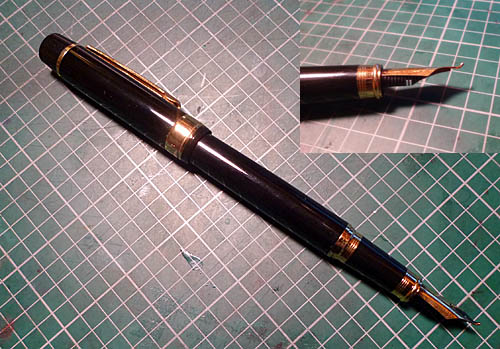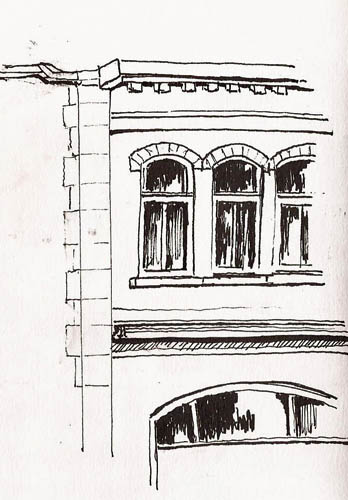Some sketchers love watercolors. Others are passionate about line. And, of course, there are those who do a combination of the two, with varying emphasis on one or the other.
For myself, if I had to do one or the other, line work, particularly that made by fountain pen, would be my choice. My use of watercolor is similar to what I did with crayons when I was a kid – I “color” inside the lines.
My lines tend to be thin and my favorite pens are those that produce them. Pens like the Pilot 78G, Pilot Prera, and Platinum Carbon pen are among my favorites. My TWSBI Mini produces a slightly heavier line but even it is finer than the typical “medium nib” pen.
One intriguing exception in my personal fountain pen mountain (and I swear that I need them all) are my Hero “calligraphy” pens. Some call them “bent nib” pens. The “calligraphy” moniker is misleading for western-worlders as they don’t work at all like western calligraphy pens but are, rather, designed for writing Chinese characters. You affect line width by varying the pen angle rather than pen direction as with a western calligraphy pen.
There are several companies that produce them but Hero is the company that seems to make the largest number of models. They are available in North America for not much money via eBay but one must be careful to ensure you’re getting a calligraphy pen as Hero makes standard fountain pens as well.
I have several of them and I’ve played with them some but have never taken them seriously. I’ve decided to change that and really learn to use them. To me, their big advantage is the ability to generate very wide lines as well as fine ones, permitting the creation of larger dark areas in a pen sketch. Their downside is that I can’t get as fine a line as I can from some of the other pens I’ve mentioned.
I was out the other day and I did this quick sketch from the 2nd floor dining area of our downtown McDonalds. You can see how even an inexperienced person like myself can generate high contrast sketches using the pen. Here I’m using a Hero 578, which is a fairly heavy pen but I like how it feels in my hand.
Later, while at the Musée d’Amerique Français I sat in a comfy chair, looked out the window and sketched this portion of one of the seminary buildings.
The folks who have the most experience with these pens are the Singapore urban sketchers. Maybe with some practice I can begin to emulate them.




Hi Larry,
does the Pilot 78G come in EF? Or does it only come in Fine? I really like the thinness of the Platinum Carbon Pen, and I have that it does not carry well and keeps falling on the floor -) I have gone on EBay and can only see the Fine Pilot 78G.
Could you also let me know if the Pilot Prera, which is more expensive, is as fine as the Platinum Carbon? If it is, I will then buy.
Thank you for posting this, and good job!
I can’t believe it, Jane. I just wrote a very long response to you and it disappeared into the ether. Oh well, try, try again.
You’ve asked what appears to be a couple very simple questions but the reality is more complicated. I hope I don’t bore you with the answer 🙂
Simple answers: The Pilot 78G comes in broad, medium, and fine. My ‘fine’ pen of choice is the Pilot Prera and if asked to use only one, it would be the Prera. BUT…
There are some things that make the simple answers to be lacking. I’ll try to outline those. First, though, you should know how I use the pens we’re talking about as that affects greatly my point of view and the very basics I’m talking about. First, almost all of my sketching takes place on Stillman & Birn Alpha and Zeta paper, though I have filled one Beta book. I also do a LOT of quick-sketching in ‘el cheapo’ dollar store sketchbooks. Mostly, I use Noodler’s Lexington Gray or Platinum Carbon Black ink. Only Lex Gray in my 78Gs. I also carry a 78G with diluted Lex Gray ink for my quick-sketching.
One last thing about ‘me’ and my advice. It’s based upon a limited sample size, though a larger one that most Internet advice I see. I own/use:
3 – Pilot 78Gs
2 – Pilot Preras
1 – Platinum Carbon (lost one and had to replace it)
I also own dozens of other fountain pens. It’s a sickness 🙂
In short, my experience with these pens comes solely from these few examples of them.
Ok…some realities and vagaries. All pens are not graded for size equally. It may not be as bad as brush sizes but it sure can confuse you. Asians tend to grade their nibs such that any ‘size’ is finer than a nib of that size from a European company. So, a Pilot “fine” is actually finer than a Lamy “extra fine” and not by a little. A Lamy XF nib will write sort of like a Micron 03 whereas my Pilot fine nibs are more like Micron 01 or even 005s when they’re new. This gets more complicated when Asian companies decide to use European nibs, as TWSBI does. My TWSBI Mini XF lays down a line that’s significantly heavier than my Pilot Prera F. Is your head starting to hurt yet (grin)?
But it gets worse. Take two pens, particularly fine pens, stuff the same ink in them and draw on the same paper and you may well get different line thicknesses. The differences seem less for pens that are less fine and I suspect that has more to do with how well the tines are aligned, polished, etc. BUT, change the ink and the line width will change again. Change the paper and you’ll see differences again. Why doesn’t this happen with Microns? I think (the big I’m not really sure) the reason is that the Microns have ink that is formulated for that particular pen and it’s designed to come out absolutely constant. The very virtues of fountain pens (ink choices, variable line width/density) are counter to absolute consistency and one on one comparison.
There are those who swear that the Platinum Carbon pen is the finest pen there is. I disagree. It’s fine, alright, but part of its fineness comes from the use of Platinum Carbon Black ink (love this ink for watercolors) which seems to make ANY pen write finer. My big complaint with the PC is what you alluded to – it has no clip. I need a clip when I go outdoors as all my pens are clipped into my messenger bag that goes everywhere with me. I’ve tried carrying the PC with me. I lost it and had to buy another one. Also, if you want to post the cap, you’ve got to cut it down, which is ok but it makes the pen small and easy to lose when stored.
Pilot 78G vs Prera: I love my Preras. The 78G is a very cheap, plastic pen that just feels cheap in your hand. It’s sort of like your Penmanship in that respect. No big deal, of course but the Preras feel better made and probably have a better cap seal, which I attribute directly to the Prera being more likely to write first time, every time. The 78Gs sometimes have to be coaxed unless you’re using them daily. Also, the Prera, at least the clear ones, come with a cartridge converter. The 78Gs do not, though you can get a CON-50 adapter for them. One last statement is that while the nibs look identical on these two pens, I swear the Prera is the smoother writer. Maybe they polish them or something. I don’t know. Maybe it’s my imagination. What I do know is that if I want a fine line I typically grab my Prera.
Hope some of this helps. If you have more questions, feel free to email me at: larry@larrydmarshall.com
Cheers — Larry
Thank you thank you and thank you again Larry!!! This is exactly the type of information that I needed… now I do have a clear idea of where I am going — and what I will be buying. I think that I also have your sickness though… and it is contagious -))) I will test out my pens on different types of paper and look at the outcome. Yes!!!
Glad you found the information helpful, Jane. The thing about a pen habit is that it’s relatively inexpensive compared to many other vices. At least that’s what I tell myself 🙂
Cheers — Larry
Larry, I enjoy your write up pens. I was lucky to find a Hero 86 on Ebay. I finally had the opportunity to play with it over the weekend. It is a fun pen. I can get a fine line if I hold the pen or nip upright. My favorite pen at the moment is the Carbon Platinum. I have the carbon ink and I am too scared to put the ink in my other pens. I also have a TWSBI Mini pen and Lexington Gray ink. Purchased after reading your reviews. Love both the pen and the ink. Thank you for your reviews!
Hi Carmel,
I’m glad that you find my comments about fountain pens useful. I got a Hero 86 recently as well. It has the small Hero nib. I don’t like the body of that pen at all, particularly because it can’t be posted properly and as a street sketcher that’s important to me. But it’s easy to pull the nib and stick it into a Noodler’s Creaper, which I did.
You’re right about the bent-nib pens. I can get fine lines by holding it vertical. I do find it harder to draw that way, though.
Platinum Carbon Black ink: I’ve heard/read all the dire warnings against Platinum Carbon Black and I think they’re worth heeding. It is a pigmented ink, though one designed for use in fountain pens. I think the real problem, though, is that most fountain pens evaporate ink as they sit around, concentrating the ink that remains. Different pens do that to varying degrees depending upon how well the cap seals. If I put a full Noodler’s Ahab on my desk, within a week or so it will be nearly empty whether I use it or not. In contrast, my TWSBI Mini has a triple seal cap and it can sit around for months and still has a wet nib when I open it. It’s not surprising that my trial with PCB in the Ahab didn’t go well but I’ve been using PCB in my TWSBI for months without problems.
Lexington Gray: Great ink and the only one that lives up to the ‘bulletproof’ claim that Noodler’s puts on its inks, though in fairness to Noodler’s they don’t define ‘waterproof’ in the same was as ink and wash artists do. I use it almost exclusively in my Pilot Preras.
Cheers — Larry